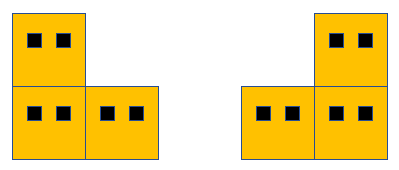Copyright © University of Cambridge. All rights reserved.
A City of Towers
In a certain city, houses have to be built in a particular way.
There have to be two rooms on the ground floor and all other rooms have to be built on top of these.
Families are allowed to build just one room for each person living in the house.
So a house for two people would look like this:

but a house for three people could look like one of these:

What might a house for four people look like?
In how many different ways could a family of four people build their house?
What about a house for five people?
In how many different ways could a family of five people build their house?
What do you notice?
Now predict how many ways there are to build a house for a family of seven people.
Try it! Were you right?
Will your noticing always be true? Can you create an argument that would convince mathematicians?
Printable NRICH Roadshow resource.
Why do this problem?
This problem is essentially an investigation into combinations of a number of cubes. It is a practical activity which involves visualising and relating 3D shapes to their representation on paper. Young children are often introduced to sets of regular polyhedra and similar sorts of shapes, less often do they
systematically explore shapes made up from cubes.
Possible approach
You could start with this story as an introduction to the problem. Alternatively you could simply talk through the problem as it is written. Ideally, it would be good to supply interlocking cubes or other cube bricks to represent the rooms and 2cm squared paper or plain paper for recording. It might help
to begin the challenge all together before asking children to work in pairs on the problem so that they are able to talk through their ideas and compare their results with a partner.
Some children may need help recording their models but do encourage them to record in whatever way they feel is useful. If necessary, you could demonstrate on the interactive whiteboard. If 2cm cubes have been used then they can lay their shape on the paper and see how it fits into the squares. Alternatively, children might just sketch their models on plain paper or, if you have enough
cubes, they can keep each model.
In the plenary, as well as comparing results, it would be good to spend time talking about how the children approached the problem. Some children might have made the models, some might have been able to picture the houses and draw them without using cubes. It can be useful to discuss the advantages and disadvantages of each different method. Depending on the children's experience, you can
also draw attention to those that have used a systematic way of finding all the houses. If most of the children have not developed a system, you could line up models in a particular order for all to see so that they notice the system themselves. This way, they may be able to spot any that are missing.
What did they notice about the number of houses that are possible? Is it always going to be the case that the total number of different houses for a particular number of rooms is one less than the number of rooms? Can the class create a convincing argument?
Key questions
Are all your houses different from each other? How do you know?
Could you put this room in a different place?
How will you draw your houses?
Possible extension
What would happen if the rooms were different colours? Some children could create their own rules for building houses.
Possible support
Having practical resources will help all learners access this task.

